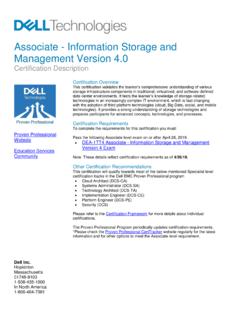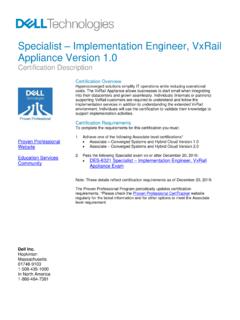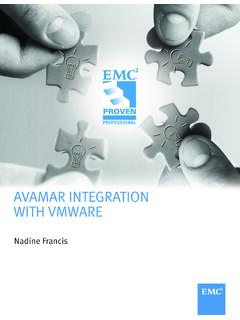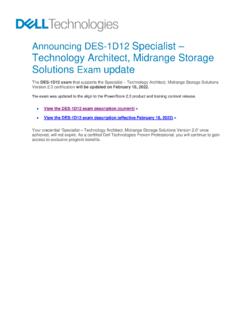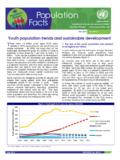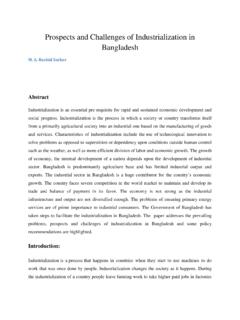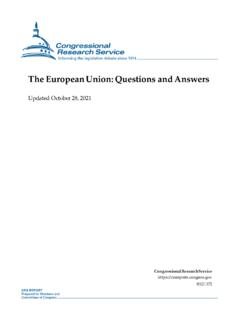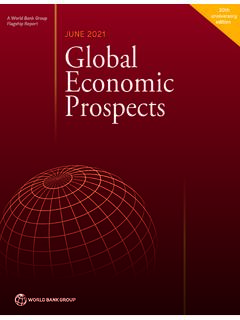Transcription of IOT SECURITY: CHALLENGES, SOLUTIONS & FUTURE …
1 iot security : challenges , SOLUTIONS & FUTURE PROSPECTSM ikhail GloukhovtsevSr. SOLUTIONS ArchitectDigital SOLUTIONS , Cloud & IoTOrange Business Sharing Article 2018 Dell Inc. or its subsidiaries. 2018 EMC Proven Professional Knowledge Sharing 2 Table of Contents 1. Introduction .. 5 What Is IoT? .. 5 security Role in the IoT Development .. 7 2. iot security and IoT Architectures .. 8 IoT Architectures .. 8 IoT Components .. 8 IoT Architectures and iot security .. 10 3. iot security challenges .. 13 iot security Risks and challenges .. 13 iot security Threats and 14 Attack Categorization For IoT Process Phases .. 15 Attack Categorization According to IoT Architecture .. 16 security Threats at the Sensing/Perception Layer .. 17 security Threats at the Network and Service Support Layers.
2 18 4. iot security Requirements .. 19 5. Trust, Data Confidentiality, and Privacy in IoT .. 21 Trust in IoT .. 21 Trust and security from a Device Perspective .. 21 Trust and Secure Key Storage .. 22 Identity Management .. 23 Data Confidentiality in IoT .. 23 Privacy in 24 6. security in IoT Networks .. 25 Overview of IoT Communication Technologies .. 25 security in Short-Range Low Power IoT Networks .. 27 2018 EMC Proven Professional Knowledge Sharing 3 6 LoWPAN security .. 27 security in RPL .. 27 security in Bluetooth Low Energy (BLE) .. 28 Zigbee security .. 28 RFID security .. 29 security in NFC .. 31 security in Long-Range Low Power IoT Networks .. 32 security in LPWAN: LoRa and LoRaWAN .. 32 security in LPWAN: NB-IoT and LTE-M .. 34 7.
3 Managed iot security Services: iot security -as-a-Service .. 35 8. iot security in Public Cloud .. 36 security Features of IoT Cloud SOLUTIONS .. 36 iot security in Azure .. 36 iot security in AWS .. 37 iot security in Google Cloud Platform .. 37 9. security in the FUTURE IoT Systems .. 37 Main Trends in the Next Generation iot security .. 37 Next Generation iot security : Data Confidentiality .. 39 Homomorphic Encryption .. 39 Searchable Encryption .. 39 Next Generation iot security : Trust .. 39 Trust Establishment .. 39 Blockchain and IoT: Trust in Transactions .. 39 Trust in Platforms .. 40 Identity Management .. 40 Next Generation iot security : Privacy .. 40 Privacy Through Data Usage Control .. 40 2018 EMC Proven Professional Knowledge Sharing 4 Privacy in Multifaceted and Dynamic Contexts.
4 40 10. Conclusion .. 41 11. References .. 41 Disclaimer: The views, processes or methodologies published in this article are those of the author. They do not necessarily reflect Dell EMC s views, processes or methodologies. 2018 EMC Proven Professional Knowledge Sharing 5 1. Introduction What Is IoT? The concept of the Internet of Things (IoT) was introduced by Kevin Ashton, a co-founder of the Auto-ID Center at MIT, in The vision is that objects ( things ) are connected to each other and thereby they create IoT in which each object has its distinct identity and can communicate with other objects. IoT objects can vary dramatically in size from a small wearable device to a cruise ship. IoT transforms ordinary products such as cars, buildings, and machines into smart, connected objects that can communicate with people, applications and each other.
5 There are various definitions of IoT. The International Telecommunication Union (ITU) defined the term Internet of Things as "Internet of Things will connect the world's objects in both a sensory and intelligent manner".2 In 2014, the Joint Technical Committee of the International Organization for Standardization (ISO) and the International Electrotechnical Commission (IEC) defined IoT as an infrastructure of interconnected objects, people, systems and information resources together with intelligent services to allow them to process information of the physical and the virtual world and react .3 At the IoT reception layer (Section ), sensors placed within devices, objects, and machinery collect, measure, and record information about the physical environment, such as temperature, humidity, gas pressure, and motion.
6 This information can be read, integrated and analyzed at higher IoT layers. NIST uses two acronyms, IoT and NoT (Network of Things).4 IoT is considered a subset of NoT, since IoT has its things connected to the Internet. In contrast, some types of NoT use only Local Area Networks (LAN), with none of their things connected to the Internet. 2018 EMC Proven Professional Knowledge Sharing 6 Figure 1: Key Business Drivers for IoT Development The IoT growth is driven by business needs as part of enterprise digital transformation (Fig. 1). According to Machina Research,5 the total number of IoT connections will grow from six billion in 2015 to 27 billion by 2025. It means a compound annual growth rate (CAGR) of 16%. In terms of market growth, the Berg Insight report5 predicts an increase of the global third party IoT platform market from 610m in 2015 to in 2021.
7 Figure 2: IoT Connecting Technologies and Disparate Industries 2018 EMC Proven Professional Knowledge Sharing 7 IoT SOLUTIONS not only involve various technology domains such as mobile communications, cloud, data, security , telecommunications, and networking but they also lead to cross-industrial use of data (for example, data generated in smart home and industrial applications is used in the automotive domain) (Fig. 2). This opens a possibility for establishing business partnerships between horizontal industries, such as telecommunication operators, and vertical industries, such as car manufacturers, as new business models. IoT-enabled digital transformation of business is much more than just using connected objects it makes it possible to develop innovative business models that were impossible before.
8 security Role in the IoT Development As discussed above, IoT is growing fast across various industry verticals along with increases in the number of interconnected devices and variety of IoT applications. However, IoT technologies are not mature yet and there are many challenges to overcome. security is the most significant of them. There are millions of connected devices and billions of sensors and their numbers are growing. All of them need secure and reliable connectivity. Hence, well-designed security IoT architectures are required by companies and organizations adopting IoT technologies. Indeed, the IoT threat landscape is large and growing: the attack surface is very large, as any IoT device could be a possible attack target. Some IoT devices are located in untrusted areas and attackers can gain physical access to them and even get control of the device.
9 Many IoT devices do not meet security best practices requirements such as least-privileged or role-based access. For example, many smart-home IoT devices such as TVs, webcams, home thermostats, remote power outlets, sprinkler controllers, home alarms, door locks, and garage door openers communicate over the network without any form of encryption and do not offer the user the possibility to enable strong passwords. IoT devices are resource-constrained and are designed to consume little power while at the same time providing all required functionality at a reasonable cost. As a result, security is an after-thought, often placed at the bottom of the priority list in the development lifecycle. IoT attack vectors can target devices, gateways, SIM/cell, transceivers, and wearables and can take advantage of weak passwords, lack of encryption, backdoors, etc.
10 The wide variety of IoT-specific operating systems, firmware versions (Section , Table 1), and custom configurations makes development of general iot security SOLUTIONS difficult. Monitoring and patching the various IoT OSes is a tremendous challenge. Furthermore, IoT 2018 EMC Proven Professional Knowledge Sharing 8 security SOLUTIONS should be extremely scalable to apply to an exponentially increasing number of various IoT devices. A growing variety of IoT applications creates new security challenges . In addition to traditional security domains such as cryptography, secure communication, and privacy assurances, iot security also focuses on trust/identity management (Section ), data confidentiality (see Section ), privacy protection (Section ), etc.
